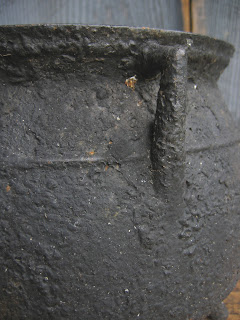





The restoration and decoration of the colonial fireplace kitchen in a restored colonial New England home has, for 150 years, been the default end-user of the witch's kettle. Occasionally a collector assembles a row of, preferably, "signed American" (maker marked) kettles with a large size cauldron or two nearby. The next tier of traditional decorative impulse is to include a small kettle next to a …not a… colonial fireplace. From an antiques dealer's vantage, the door of selling an old iron kettle, a witch's or not, nearly closes with these options. There is one grand option left.
Though never mentioned, rarely noted and of foundation level northern New England decorative pedigree… the old witch's kettle has a most prominent …and understated "place" in a properly decorated traditional New England home; the front porch. Black… against white… it rests "there".
The front porch is in front of the front door and that door is rarely used because "everyone" comes and goes through the side door that usually enters the kitchen and is back up along the side of the home. Way out at the front of the home, facing the road, is the front door… and, usually, a "porch". A wreath is put on the front door during the holidays. It is taken down after the holidays. The whole porch is repainted every dozen years. A porch rocker or too, in dark forest green paint, may sit on the porch. Very, very occasionally someone actually sits in these. The only other acceptable decorations are… a modest - NEVER TOO MANY - gathering of OLD flower pots (no hanging baskets; they are a "new" taste)… with, usually, geraniums…and a single old watering can… maybe… and… a single black witch kettle.
It may be small, to the side of the door. It may be larger; at the side of the door, out at the edge porch between the pillars… or down near the end (acting as a sort of bookend). It may be a large caldron. Any are acceptable but the knowing eye seeks a true witch's form, a single kettle only and… black. It stays there forever. FOREVER.
It is so classic… so traditional… so, so, so… proper as decoration… that it succeeds by not ever being noted. It is so traditional that it vanishes… yet a knowing eye always denotes it. It is a signature of classic traditional northern New England good taste that signals that… this taste… continues inside the whole home. That's what it does; it sends that message.
Extended, any front door anywhere may attach this iron kettle signal. Simply get one and put it out there and …never touch it again. The job is done. Helping this kettle placement… and one's wallet… is a NOT DENOTED by the antiques marketplace …necessity. The kettle one chooses, in addition to witch form, is BEST if it is cracked or has a hole in it. Or both. THIS is to allow the rain & snow water to drain out. Otherwise the kettle will get full of water, water soaked leaves and …sit there full… for no one is ever out there except once a year to "empty it". This means that one SEEKS a cracked kettle and/or a kettle with a hole in it's bottom. THESE are considered flawed kettles by the traditional antiques market so… sell for less. Hundreds of dollars less. A cracked or "with hole" kettle may be found for $75. while it's perfect specimen are usually tagged $250 and up. One wants the water to drain out so one never has to touch the kettle ever while it sits out front "forever". A cracked kettle, to me as an antiques dealer, is by far more salable.
I have pictured a front door classic. It is a two gallon classic witch form with… MANY layers of black paint. When one paints the porch white every decade, one paints the kettle… black… too. I bought this one off a porch. It is cracked. It has holes drilled in it too. It drains perfectly. It is also missing it's handle. No one will notice but… THAT… FEATURE… even further reduces the cost of the kettle; ten to thirty dollars. But again, behind this all… is FORM. It must, must, must be a witch's kettle to be "right". This one is CLASSIC form and size and sooooo front porch ready… including the paint surface heritage… that it may be considered the epitome of one's quest.

No comments:
Post a Comment